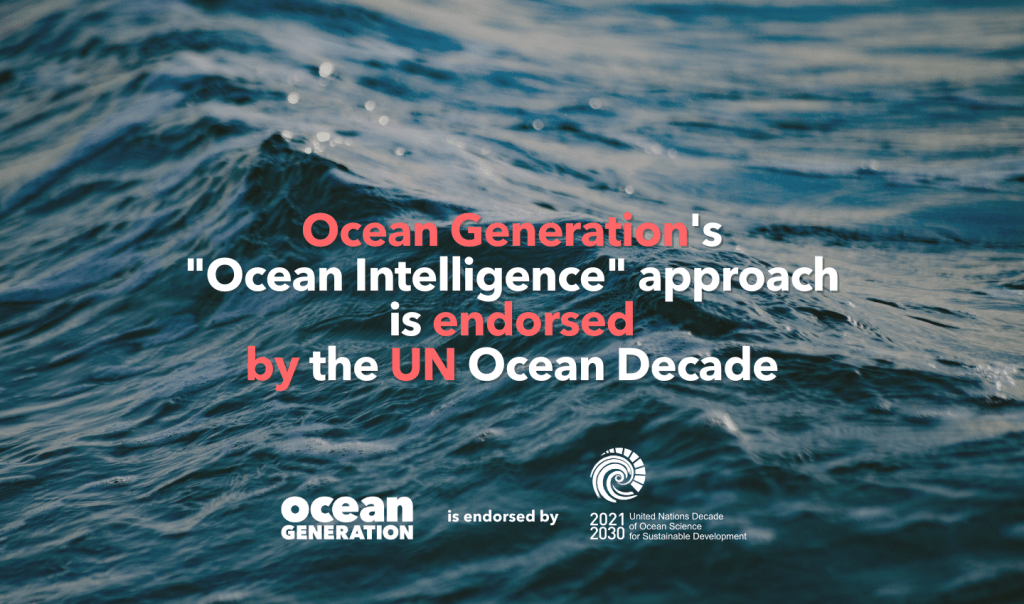- Latest News
- Our Campaigns
- Our Partnerships
- Voices of the Ocean
Ocean Generation: Endorsed as a UN Ocean Decade Project

In 2017, the United Nations General Assembly declared 2021 – 2030 as ‘the Ocean Decade’ (officially: the UN Decade of Ocean Science for Sustainable Development).
What is the goal of the UN’s Ocean Decade?
The Ocean Decade is a global effort to provide “transformative Ocean science solutions for sustainable development, connecting people and our Ocean” endorsed by the Intergovernmental Oceanographic Commission (IOC) of UNESCO; scientists, resource providers, governments, business and industry, and other stakeholders joining forces to drive solutions.
Their vision? To provide the science we need for the Ocean we want, with the aim of supporting a well-functioning, productive, resilient and sustainable Ocean.
Ocean Generation’s “Ocean Intelligence” approach has been endorsed by UNESCO; the UN Ocean Decade.

What is Ocean Intelligence?
“We are delighted that our unique Ocean Intelligence approach has been endorsed by the Intergovernmental Oceanographic Commission of UNESCO (IOC).
Richard Hill, CEO at Ocean Generation.
Our ‘Ocean Intelligence’ approach uses the power of storytelling to translate complex Ocean science into engaging programmes and practical actions.
Through Ocean Intelligence we play a central role in bringing to life the vision of the Ocean Decade by connecting everyone, everywhere to the Ocean and communicating the science we need for the Ocean we want.
We are particularly happy to continue our long relationship with the IOC who were early supporters and patrons of our original, award-winning documentary film, ‘A Plastic Ocean’.“
Ocean science can be complicated. We make it simple.
Ocean Generation uses the power of storytelling to translate environmental science into understandable, engaging content, impactful programmes and practical actions that people, globally, can take to restore a healthy relationship with the Ocean and live more sustainable lifestyles.
Our Ocean Intelligence approach is grounded in four science-based pillars:
- Our Ocean: Engaging people in the wonder of our Ocean.
- Ocean not Oceans: Sharing the Science behind one interconnected Ocean that humans rely on.
- Our Impact: Exploring the 5 human actions that threaten our Ocean.
- Our Future: Discovering how we can all take Ocean Action.
These 4 pillars underpin our Comms work, to a growing audience of +100,000, and all our Youth Engagement programmes for 3 – 25-year-olds.

How we bring the Ocean to young people
From a toe in the water to a full immersive experience
In partnership with Earth Cubs, we’ve launched a play-based game for 3 – 7-year-olds that aims to engage children on the importance of our Ocean, the harm of plastic pollution, and how they can contribute to creating a healthier planet.
Ocean Academy exists to bring the Ocean to the classroom. It’s an open-source digital education hub designed for 5 – 16-year-olds, providing them with access to the best Ocean education – in easy to understand and engage with formats.
The Wavemaker Programme empowers young adults – 16 – 25 – to make a positive change by providing them with tools and resources. Through our workshops, masterclasses, and personal development programmes, Wavemakers accelerates social action and incubates innovation.
We see a world where the Ocean is freed from human threats.
Subscribe to our newsletter and follow us online to be part of Ocean solutions.
As the first generation to deeply understand Ocean issues, we are the last generation who can stop them.
We are all the Ocean Generation.










